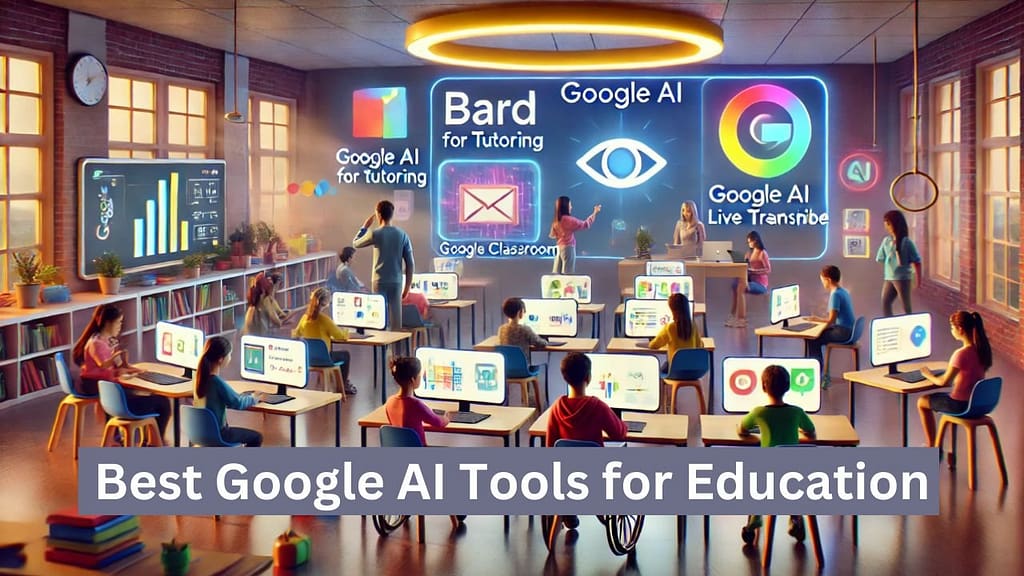Best Google AI Tools for Education Artificial intelligence (AI) is causing a significant change in education.
Google, a pioneer in AI innovation, has created a set of resources that enable institutions, teachers, and students to improve the quality of teaching and learning.
These tools automate chores, personalize instruction, and enhance learning through the use of AI technologies like as machine learning and natural language processing.
Table of Contents

Best Google AI Tools for Education In this blog, we’ll explore the best Google AI tools for education in 2025 and how they’re reshaping classrooms worldwide.
Best Google AI Tools for Education
1. Google Bard: A Personal AI Tutor
Google Bard, Google’s advanced AI chatbot, acts as a personal tutor for students. Powered by natural language processing, Bard helps students understand complex topics, solve problems, and learn new skills interactively.
Key Features:
- Interactive Learning: Students can ask questions and receive detailed, easy-to-understand explanations.
- Customizable Responses: Educators can tailor Bard to align with specific curriculum standards.
- Language Support: Bard supports multiple languages, making it accessible to students globally.
Use Case:
Best Google AI Tools for Education A high school student struggling with calculus can use Bard to get step-by-step guidance on solving equations, ensuring they grasp foundational concepts.
2. Google Classroom with AI Integration
Google Classroom has become a cornerstone of modern education. In 2025, it incorporates AI-powered tools to improve efficiency and engagement.
Key Features:
- Automated Grading: AI evaluates multiple-choice and short-answer questions, saving teachers time.
- Personalized Learning Recommendations: Based on student performance, AI suggests additional resources or assignments.
- Real-Time Feedback: AI helps teachers provide constructive feedback on essays and projects quickly.
Use Case:
Best Google AI Tools for Education Teachers can identify struggling students through AI analytics and offer targeted interventions to improve their performance.
3. Socratic by Google
Socratic is a mobile app designed to help students with homework and studying. Using Google’s AI, it offers instant explanations for math problems, science concepts, and more.
Key Features:
- Photo Assistance: Students can snap a photo of a question, and Socratic provides detailed explanations and solutions.
- Subject Coverage: Covers math, science, history, and language arts.
- Visual Learning: Includes videos and diagrams to aid understanding.
Use Case:
Best Google AI Tools for Education A student stuck on a chemistry question can use Socratic to get a clear explanation with visuals, enabling them to grasp the topic faster.
4. Google Lens for Learning
Google Lens, primarily known for its image recognition capabilities, is now an invaluable educational tool.
Key Features:
- Text Recognition: Instantly digitize text from books or handwritten notes.
- Translation: Translate text from one language to another, supporting language learners.
- Search Integration: Highlight text or images and receive relevant search results for deeper understanding.
Use Case:
A student reading a biology textbook can use Google Lens to scan a complex term and receive a definition, pronunciation, and related videos.
5. Google AI for Accessibility: Lookout and Live Transcribe
Google’s AI-powered accessibility tools like Lookout and Live Transcribe ensure inclusive education for students with disabilities.
Key Features of Lookout:
- Object Identification: Helps visually impaired students recognize objects and text.
- Text-to-Speech: Reads out scanned text for users.
Key Features of Live Transcribe:
- Real-Time Transcription: Converts speech to text, aiding students with hearing impairments.
- Multi-Language Support: Enables participation in multilingual classrooms.
Use Case:
A visually impaired student can use Lookout to navigate educational materials, while Live Transcribe ensures they don’t miss out on classroom discussions.
6. Google AI-Powered Search in Education
Google’s search engine, now enhanced with AI, serves as a learning assistant for students and educators.
Key Features:
- Detailed Summaries: AI-generated summaries of complex topics streamline research.
- Educational Filters: Search results prioritize credible and academic resources.
- Math and Science Solvers: Built-in tools solve equations and graph functions.
Use Case:
Students working on a research paper can quickly find credible sources and get AI-assisted explanations of complex topics.
7. Google Translate with AI Enhancements
Google Translate, now powered by advanced AI, is an essential tool for language learners and multicultural classrooms.
Key Features:
- Natural Language Translation: More accurate translations with context-sensitive suggestions.
- Conversation Mode: Facilitates real-time bilingual communication.
- Practice Tools: Interactive features to help students practice new languages.
Use Case:
A teacher in a diverse classroom can use Google Translate to communicate with parents who speak different languages, ensuring inclusivity.
8. Google Scholar with AI-Powered Research Assistance
Google Scholar has integrated AI features to assist students and researchers in finding academic papers, citations, and summaries.
Key Features:
- Paper Summarization: AI-generated abstracts provide a quick overview of research papers.
- Citation Assistance: Automatic generation of citations in various formats.
- Research Suggestions: AI recommends related topics and papers based on user interests.
Use Case:
University students working on a thesis can use Google Scholar to find relevant studies and quickly generate a bibliography.
9. Google Earth and Expeditions
Google Earth and Expeditions make geography, history, and environmental science lessons come alive through virtual tours and immersive experiences.
Key Features:
- 3D Visualization: Explore landmarks, cities, and ecosystems in 3D.
- Virtual Field Trips: Take students on guided tours to historical sites and natural wonders.
- Interactive Lessons: Incorporates quizzes and activities to reinforce learning.
Use Case:
A geography teacher can take students on a virtual tour of the Amazon rainforest, providing an immersive learning experience.
10. AI-Powered Jamboard
Jamboard, Google’s collaborative digital whiteboard, now includes AI features to enhance classroom creativity.
Key Features:
- Shape Recognition: AI converts rough sketches into polished diagrams.
- Idea Suggestions: AI provides prompts and suggestions during brainstorming sessions.
- Collaboration: Enables real-time collaboration between students and teachers.
Use Case:
A history class can collaboratively create a timeline of events with AI assistance on Jamboard.
Conclusion: Best Google AI Tools for Education
Best Google AI Tools for Education Google’s AI tools are revolutionizing education in 2025, making learning more personalized, accessible, and engaging. From AI-powered tutors like Bard to collaborative platforms like Jamboard, these tools cater to diverse learning needs.
As technology continues to evolve, the integration of AI in education will become even more seamless, empowering teachers and students to achieve their full potential. By embracing Google’s AI tools, educators can create dynamic and inclusive learning environments that prepare students for the future.
